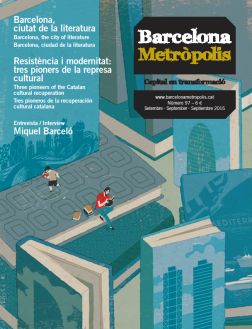One of the duties of a city’s institutions is to make the invisible visible. In other words, to make the people aware of their intangible heritage, highlighting it in a tangible way. Symbolic history, therefore, has to be set in motion alongside economic, social, political and urban history.
Barcelona, the capital of Catalonia, one of the most important cities in the world’s tourism industry and the global economy, could soon become the capital of a state. Its national and international significance seems quite apparent in the geoeconomic and geopolitical spheres. But is it also a cultural capital?
Walter Benjamin’s brilliant phrase, Paris, capital of the 19th century, not only synthesised the significance of Paris, it also allowed us to think in terms of the capital of a historical period. London, capital of the 18th century? It could be, but then the 19th century would really start in 1751, with the first volume of the Encyclopédie. And what would we do about Le Siècle de Louis XIV, a term coined by Voltaire? And which would be the capital of the 20th century? Maybe each decade has had a cultural capital, or none at all, or several cities bidding for the title, like Barcelona or Buenos Aires in the first third of the 20th century when they both went to great lengths to achieve this position, and both of which are still feeling the ripples created by that great desire. Berlin also wanted to be the capital of the 20th century and it almost was, but an end was brought to that attempt in the most horrifying of ways. New York was the undisputed capital, at least between 1945 and… 2001, while in Europe the century ended in 1989. No: we no longer need to find a capital of the 20th century, but neither can we get around the fact that, on the map of globalisation, cities are one of the few stable landmarks. Despite all the misunderstandings about local and global, big cities continue to be a source of tangible and intangible value. In this sense, cities are capitals.
The most successful attempt at defining the concept of a cultural capital (city) has been made by Christophe Charle and his collaborators. According to them, a cultural capital is the result of an accumulation of cultural institutions and cultural production by successive generations, of recording this cultural history in specific places and of constantly questioning where the line is drawn between different sectors of cultural life. As a result of this process, a particular urban space becomes a magnet and a centre of power for an area of symbolic production. Finally, the accumulation of symbolic capital and the way it is managed or squandered, determines the longevity of this cultural capital or, if capital becomes static, its transformation into a museum piece which sooner or later is used up if it fails to reinvent itself.
It is not necessary to be a state capital to be a cultural capital, but if a city is the centre of a cultural field this condition cannot be ignored if we are to speak of its potential as a capital. Moreover, being or not being the capital of a state grants certain supranational characteristics that are very different from cultural fields. Being a cultural capital, therefore, means being defined in national terms. This definition was given by the artiste démolisseur, the Parisian prefect of the Seine, Georges-Eugène Haussmann, who concluded in an 1868 prefecture report: “It is difficult to find in the two million inhabitants that make up the population of Paris even the slightest of municipal ties, the slightest affinity with origin […] Isolated and lost in the midst of the variegated multitude of the capital, Parisians have no way of counting themselves or grouping themselves. For them, the municipality does not exist, it can’t exist […] Paris, because of the heterogeneous, mobile, cosmopolitan make-up of its inhabitants, cannot be considered a municipality. It is something else entirely. It is a capital […], in other words, it is the collective property of the whole country and the city of all Frenchmen.”
This definition of Paris as a capital is extremely interesting because, starting from a tangible reality, it insists on the recognition of an accumulated capital and, above all, of the possibilities gravitating around it. The loss of Parisian cultural specificity is one price that must be paid for its capital status, but Paris has found ways of responding to the obliteration of its daily life.
Decades later, Gabriel Alomar reached similar conclusions about Barcelona as the capital of Catalonia:
“Maybe we can briefly summarise – time now allows us to do so – the overall evolution of our catalanism… No, no: I’ve drawn a big line through the word catalanism, and I’ve written this other word in upper case, a word that it is now time to proclaim, a word that comes much closer: BARCELONISM; the flowering of the City, no longer of the Nation. So, the three periods of our movement are: I. Regionalism; its watchword: the Floral Games poetry contests; its Home: Catalonia. II. Nationalism; its watchword: Solidarity; its Home: Spain. III. Citizenism; its watchword: our youth; its Home: Barcelona, in other words, the world.
“Imagine the joy of being able to say without distinction Barcelona or Catalonia as labels for a single city, the soul of an entire world; as was said of Rome; and of seeing the city no longer as a tangible product or the result of a nation, but seeing the nation as a spiritual product, an emanation or creation (in theological terms) of our city.”
A project of modernity
Alomar was a Majorcan who had settled in a Barcelona that had come a very long way in a very short time, thanks to Modernisme and the early stages of Noucentisme, which would soon see the formulation of the idea of Catalonia-city, which should be evoked in these terms. The way that the aesthetic and artistic ethos of Modernisme and Noucentisme (almost polar opposites) took root in Barcelona, with their respective political agendas (more similar than they may appear) shows us how Barcelona articulates its arguments on what the city should be like, with an ability to absorb international debates and a definitive way of spreading its project of modernity to the whole of Catalonia. Writing, as a spiritual space within the city, began with reading the morning papers and the articles that, by the afternoon, had already showed promise as book chapters, and from one page to the next, an idea of Barcelona began to take shape. When set in motion, a city’s symbolic capital is exactly that. Barcelona is a very clear example, and one of few in Europe.
So, we might say that the city is the ideal place for accumulating symbolic capital unbound by its own municipal borders. For a city to become a cultural capital it has to attract the best sources of energy from within its own cultural field and others, through a reciprocal relationship in the international intellectual space.
The transformation of a city into a cultural capital has a lot to do with a range of complex elements that settle on the ground spontaneously, compiling strata little by little with reliefs and contours that are recognisable locally, nationally and internationally. Without slipping into dirigisme, a cultural capital only works with clear, long-term institutional backing. One of the duties of a city’s institutions is to make the invisible visible. In other words, to make the people aware of their intangible heritage, highlighting it in a tangible way. Symbolic history, therefore, has to be set in motion alongside economic, social, political and urban history.
Barcelona is not Kafka’s Prague, Pessoa’s Lisbon, James Joyce’s Dublin nor Borges’ Buenos Aires. Neither is it a Paris crammed with little spaces forever linked to a name or an era. In this sense, it is more like Berlin, Stockholm, Vienna or Budapest. But the important part that writers such as Verdaguer, Rusiñol, Maragall and Eugeni d’Ors have played in the definition of Barcelona cannot be understated. Indeed, they are the key piece in its contemporary symbolic history. Maybe this is one of Barcelona’s unique characteristics as a cultural capital: it is a city in which writers have channelled thinking on the idea of the city in both local and European terms. In its relationship with other cities and cultures, its own cultural heritage has been a vital element for over a century and a half: this is capital that is simultaneously its own and shared.
It is very difficult to articulate this clearly and consciously without it looking like inconsequential dirigisme or grandiloquent planning. Barcelona has to rethink its model of cultural policy in line with the capital concept. This does not mean simply creating more facilities, but building a conscious and critical relationship with its own tangible and intangible heritage. That is why the Vil·la Joana-Verdaguer House of Literature is one of the most important and groundbreaking initiatives that falls within this idea of Barcelona as a cultural capital. It is a major shift in approach, founded on research and not on promotion. This idea could also be reinforced by UNESCO’s designation of Barcelona as a City of Literature within the Creative Cities Network. Both of these initiatives are serious mid- to long-term projects. The MUHBA-Vil·la Joana provides a centre for research and debate on the relationship between literature and the city, with a view to world literature. Designation as a UNESCO City of Literature would provide recognition of a context in which literature – and books in general – play an essential role in public life and not just as an economic driver (which they are as well).
In any case, Barcelona’s success as a cultural capital depends on its people’s ability to remember that all they are really doing each day is receiving capital formed by relationships with the world; making it grow through smart decisions and focused efforts, caring for it. And when the time comes, being able to think of it a generation later and finding that it has grown. That would be no mean feat.





Pingback: Barcelona, proclamada ciutat literària per la UNESCO | Núvol